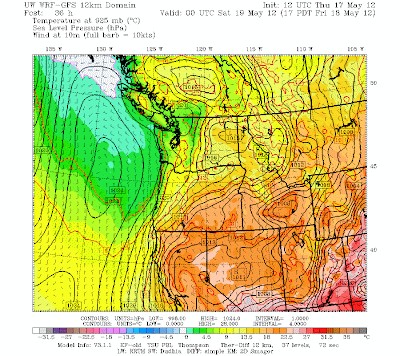As we enter the warm portion of the year, differences between Portland and Seattle temperatures are again becoming evident. Seattle has a far more maritime climate than Portland and thus is considerably cooler during the summer. In fact, the Willamette Valley as a whole has a far more continental climate than the Puget Sound basin.
To illustrate this situation, consider some topographic maps. Seattle is clearly open to the influence of cool waters, with Puget Sound at its front door and a sea level path to the Pacific Ocean. With water next store and high pressure offshore, constantly pushing marine air into the Puget Sound interior, it is hard to get the Puget Sound lowlands in the 80s or 90s during the summer. Only when we have strong offshore and downslope flow can Seattle and vicinity get toasty.
But Portland and the Willamette Valley are another story! The Willamette River or even the Columbia is no Puget Sound, and the Willamette Valley is surrounded by mountains or high hills on all sides, thus isolating it from the marine influence during the summer--a period when the Pacific cool, marine layer is relatively shallow and unable to surmount the terrain. Thus, it is far easier for Portland to bake...and it is not unusual for the high temperatures from Portland to Eugene to be 5-10F warmer than Seattle...sometimes much more.
Lets begin by looking at the monthly average maximum temperatures at Seattle, Portland, and Salem.
Consider July. In that month Seattle has an average high of 75, Portland gets to 79, and Salem, a torrid 82F. Not need to head to Hawaii...drive down to Salem. But look at the winter high temperatures...there is very little difference among these three stations...and that is not surprising. With strong, deep flow coming off the Pacific and lots of clouds, we all suffer with cool, wet conditions.
But the mean monthly temperatures tell only part of the story...what about the extremes? Below is a plot of daily means and extremes...lets consider the daily extreme high temps (yellow colors). Seattle has only gotten above 100F once---103F in July 2009. But for Portland, daily records above 100F are numerous and above 90F commonplace over most of the summer....very different than Seattle!
Lets illustrate with last summer: here is the plot of temperatures at Portland (green line) and Seattle (red line for July 1, 2011 to Sept 1, 2011. Portland is warmer on virtually every day, sometimes by as much as 10F. They just don't have Seattle's natural air conditioning. But they do have better food trucks, several of which sell cooling drinks and ice cream.
And if you think the Willamette Valley is warm during the summer...it is nothing compared to the next basin to the south...the one including Medford and Ashland. They laugh at 100F temps down there....but that is a story for another day, and one that includes fog during the winter.
To illustrate this situation, consider some topographic maps. Seattle is clearly open to the influence of cool waters, with Puget Sound at its front door and a sea level path to the Pacific Ocean. With water next store and high pressure offshore, constantly pushing marine air into the Puget Sound interior, it is hard to get the Puget Sound lowlands in the 80s or 90s during the summer. Only when we have strong offshore and downslope flow can Seattle and vicinity get toasty.
But Portland and the Willamette Valley are another story! The Willamette River or even the Columbia is no Puget Sound, and the Willamette Valley is surrounded by mountains or high hills on all sides, thus isolating it from the marine influence during the summer--a period when the Pacific cool, marine layer is relatively shallow and unable to surmount the terrain. Thus, it is far easier for Portland to bake...and it is not unusual for the high temperatures from Portland to Eugene to be 5-10F warmer than Seattle...sometimes much more.
Lets begin by looking at the monthly average maximum temperatures at Seattle, Portland, and Salem.
Consider July. In that month Seattle has an average high of 75, Portland gets to 79, and Salem, a torrid 82F. Not need to head to Hawaii...drive down to Salem. But look at the winter high temperatures...there is very little difference among these three stations...and that is not surprising. With strong, deep flow coming off the Pacific and lots of clouds, we all suffer with cool, wet conditions.
But the mean monthly temperatures tell only part of the story...what about the extremes? Below is a plot of daily means and extremes...lets consider the daily extreme high temps (yellow colors). Seattle has only gotten above 100F once---103F in July 2009. But for Portland, daily records above 100F are numerous and above 90F commonplace over most of the summer....very different than Seattle!
Lets illustrate with last summer: here is the plot of temperatures at Portland (green line) and Seattle (red line for July 1, 2011 to Sept 1, 2011. Portland is warmer on virtually every day, sometimes by as much as 10F. They just don't have Seattle's natural air conditioning. But they do have better food trucks, several of which sell cooling drinks and ice cream.
And if you think the Willamette Valley is warm during the summer...it is nothing compared to the next basin to the south...the one including Medford and Ashland. They laugh at 100F temps down there....but that is a story for another day, and one that includes fog during the winter.





























































